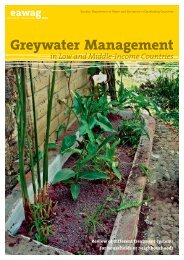Household Water Treatment and Safe Storage Factsheet: Source ...
Household Water Treatment and Safe Storage Factsheet: Source ...
Household Water Treatment and Safe Storage Factsheet: Source ...
Create successful ePaper yourself
Turn your PDF publications into a flip-book with our unique Google optimized e-Paper software.
<strong>Household</strong> <strong>Water</strong> <strong>Treatment</strong> <strong>and</strong> <strong>Safe</strong> <strong>Storage</strong><br />
<strong>Factsheet</strong>: Nalgonda Technique<br />
Operation<br />
The Nalgonda Technique is a bucket system<br />
designed to be used on a household scale. It<br />
consists of a 40 litre plastic bucket with a tap<br />
located 5 cm above the bottom of the bucket.<br />
The process involves adding aluminum sulfate,<br />
lime <strong>and</strong> bleaching powder (optional) to the<br />
water in the bucket, followed by rapid mixing<br />
for 10 minutes. The water is then left to st<strong>and</strong><br />
for 1 hour. After coagulation/flocculation <strong>and</strong><br />
settling are complete, the treated water is<br />
poured out through the tap, <strong>and</strong> stored for the<br />
day's drinking in a clean bucket or safe storage<br />
container.<br />
The dose of alum to be added depends on the<br />
fluoride concentration <strong>and</strong> the alkalinity of the<br />
raw water (see table below from Lyengar,<br />
2002). The dose of lime to be added is 5% of<br />
the amount of alum (Lyengar, 2002).<br />
Lime is added to maintain the neutral pH in the<br />
treated water. Excess lime is used to help<br />
sludge settling as it helps form denser<br />
(heavier) flocs, which speeds up settling.<br />
This technique produces large quantities of<br />
sludge. The environmental impact of the<br />
hazardous sludge disposal should be<br />
considered.<br />
Moreover, care has to be taken to avoid the<br />
presence of aluminum in the treated water, as<br />
this may have adverse health effects. With this<br />
technique, the free residual aluminum content<br />
in the treated water can be as high as 2.01 to<br />
6.86 mg/L (Kailash et al., 1999). The maximum<br />
limit is 0.2 mg/L aluminum.<br />
Alum <strong>and</strong> Lime Dosage for the Nalgonda Technique<br />
(Credit: Lyengar, 2002)
















